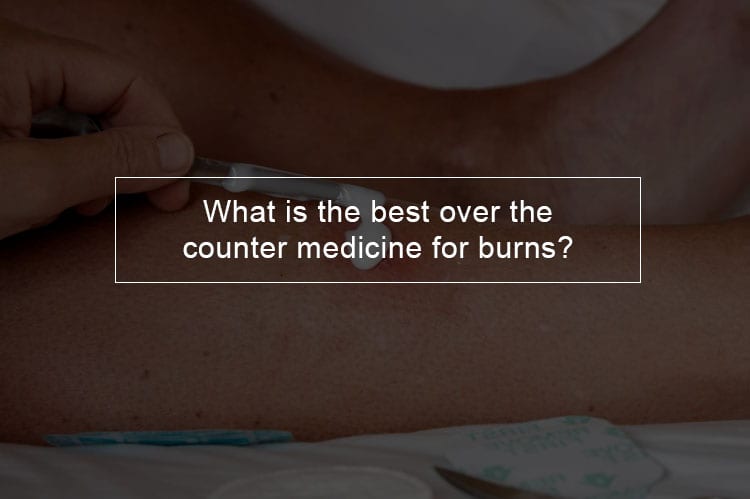
Appropriate first aid must be used to treat any burns as soon as possible. This will reduce the amount of damage to your skin. In this article, we will explore first aid techniques for yourself or another person who has been burnt.
What is the best ointment for burns?
Burn ointment
Some burns can be treated at home or with over the counter medications, while others require medical attention.It is essential to know which home remedies and ointments are suitable and also to recognize when to have a burn treated by a doctor, as complications can develop. Before we discuss the ointments to use, let's look at how to determine when to use an ointment to treat a burn.
How severe is the burn?
Typically burns can be described in four levels:
- First-degree burn: a minor and least severe burn, which affects only the epidermis (outer layer of the skin).
- Second-degree burn: this is the least severe burn and affects the deeper layers of the skin.
- Third-degree burn: Without the fourth degree, it is the most severe burn, which affects all layers of the skin.
- Fourth-degree burn: this is the most serious burn, which causes damage to bones and joints.
First and second-degree burns can frequently be treated at home with ointments and other home remedies. Typically, there are no complications and healing will occur with minimal intervention. A first-degree burn will heal in seven to ten days. A second-degree burn usually heals within two to three weeks. A person should watch for signs of further infection that may require further medical attention. You can apply ointment to a burn at when dressing or after dressings.
Dressing a burn
There is a wide range of dressings which can be applied to burns. The essential principles are to keep the wound clean and moist during healing. If there are blisters, the burn has been broken, use a protective dressing. An antimicrobial dressing is generally recommended. Silver dressings, which come in many forms such as nanocrystalline silver sheets, silver impregnated foam, or products such as chlorhexidine-impregnated tulle gras can be useful for their antimicrobial features. If any symptoms of infection develop, patients should be referred to a burn unit.
Dressings should be applied according to the producer's commendations. The frequency of dressing varies from daily to weekly and is determined by the product used and the amount of burn exudate. While doctors favor less expensive dressing, frequent dressing changes and a lower chance of infection may be relatively costly antimicrobial dressings more cost-effective. As burns are excruciating, less dressing changes, and thus less associated procedural pain and distress, are highly desired and may expedite healing.
Silver sulfadiazine cream
Creams containing silver sulfadiazine are commonly used to treat burn injuries. While an effective antimicrobial, silver sulfadiazine requires daily dressing changes, which can be labor intensive for distressing patients.
With the advancement of technology, the role of silver sulfadiazine should be limited to treating infected burns. If used on the infected burn, silver sulfadiazine cream should be applied onto a sterile cloth. This makes sure that it remains in contact with the burn wound.
Moisturizing creams for burn
Burn injuries frequently lead to dry skin, so moisturizers are commonly recommended. There are many moisturizing products accessible, but a pure water-based sorbolene cream is very efficient and cost-effective. In patients with intact, non-blistered skin, moisturizing cream may be used for primary wound management. Dry skin can sometimes persist for several months after the burn has healed. Regular application of water-based moisturizing cream is commended. Nevertheless, moisturizing products containing sodium lauryl sulfate, such as aqueous cream, are not recommended as they have shown some cases of worse dryness. There is less evidence that adding vitamin E to sorbolene cream leads in scar reduction, but such creams are commonly used.
What painkiller is best for burns?
Antibiotic ointment for burns
Pain is an unfortunate part of burn injury and recovery of a burn. Burn pain can cause discomfort while sleeping, limit the ability to work even lead to depression. There are various types of burn pain, and each person's pain and each person's pain is unique. Understanding the type, intensity and duration of pain are essential for getting the best painkiller.
Understanding the pain of a burn
The following are various types of burn pain:
- Acute pain: this is a short, intense pain that typically occurs during a procedure like dressing changes or physical therapy.
- Resting therapy: background pain which one feels almost everywhere.
- Breakthrough pain: pain that comes and goes all through the day, frequently as a result of wound healing.
- Chronic pain: Ongoing pain which lasts for six months or longer after the burn wound has been cured.
- Chronic pain: Ongoing pain which lasts for six months or longer after the burn wound has been cured.
- Neuropathic pain: this is pain that occurs as a result of damage of re-growing or nerve endings in your skin.
You must also be able to describe the intensity of the pain:
- How intense the pain is, frequently rated on a scale of 0 to 10.
- The duration of the pain; how long it lasts
- When the pain gets worse such as during the day, night, or during certain activities.
- You should also be able to tell the quality of the pain, for example stinging, throbbing, itching, and shooting.
- You should also describe the impact of the pain; that is how it affects your emotions and your ability to do things.
- Tell your doctor if the pain is related to itching, which may be a symptom that the skin is healing.
Pain medications
Opiates are the most common painkillers given in a hospital for burn pain relieve. They may be less effective for chronic pain and has side effects such as constipation and low mood. Thus, the physician can help you taper off opiates when necessary to avoid withdrawal signs.
Pain medications such as non-steroidal anti-inflammatory are available over the counter and can be used for long term pain relief. You should not use this medication without doctor supervision to avoid side effects. You may also use anticonvulsant medications, such as gabapentin and pregabalin to manage pain. However, the effectiveness can vary from person to person.
If you the pain is interfering with sleep, talk to your doctor about sleep medications. Some antidepressants offer pain relief for some people, even if they are not depressed. They can also help with sleep. Beside the painkillers, you also need to use behavioral approaches to make the pain manageable.
How do I heal a burn quickly?
How to heal a burn fast
In this section, we will discuss when to call 911 because of a burn and the fast aid for the first, second and third degree burns.
When to call 911 for a burn?
- If the burn infiltrates all layers of the skin
- If the skin is leathery or charred looking, with white, brown or black patches
- If the hands, feet, face or genitals are burned
- If the individual who suffered the burn is a senior or infant
How to heal all degree burns fast?
Step 1: Stop burning immediately
- If the burn is caused by fire, stop the person's contact with the hot steam, object or liquid.
- Help the person involved -stop, drop and roll to softer flames
- Remove hot or burned clothing. If clothing sticks to the skin, tear or cut it around
Step 2: Remove constrictive clothing immediately
Take off jewelry, belts and tight clothing. Burns can inflame fast' Take the following measures:
For 1st-degree burns
This burn affects the epidermis
Step 1: Cool the burn
- Hold the burning skin under running water or submerge in cold water until the pain disappears.
- You can use a compress if running the water is not available
- Remove hot or burned clothing. If clothing sticks to the skin, tear or cut it around
Step 2: Protect Burn
- Cover the burn with a non-adhesive dressing or a piece of clean cloth.
- Do not apply oils and butter, as they can cause infection.
- Treat the pain resulting from the burn
- Take over the counter painkillers such as naproxen, ibuprofen, and acetaminophen.
Step 3: When to visit a doctor
Visit a doctor if:
- In case you see any signs of infection, such as excessive pain, redness, bumps, and fever or oozing
- The blister is large and oozes
- The person requires tetanus depending on the date of the last injection.
- The doctor will assess the burn and may prescribe antibiotics and pain medication.
For second-degree burns
This burn affects the two outermost layers of skin.
Step 1: Cool the burn
- Submerge in cold water for ten to fifteen minutes
- If there are no running water use compresses
- Do not use Ice; it can lower the body temperature and result in further pain
- Do not break blisters or smear butter or ointments, which can cause infection.
Step 2: Protect Burn
- Cover the burn region with a sterile bandage and secure it in place with gauze or tape.
- Prevent shock
- Not unless the victim has a head, neck, or leg injury, or it would result in discomfort
- Lay the person flat
- Cover the person who has suffered the burn with a coat or blanket
- Elevate feet about 12 inches
Step 3: You can see a doctor to test burn severity, prescribe antibiotics and pain medical interventions, and administer a tetanus injection if needed.
For third-degree burns
Step 1: Call 911 in case of a third-degree burn
- Cover the burn with loosely with a sterile bandage or a material that will not allow lint in the wound.
- If the burn has affected the toes or fingers, separate burned toes, and fingers with dry, sterile dressings.
- Don't splash the burn in water or apply treatments or butter, which can lead to infection.
- Do not break blisters or smear butter or ointments, which can cause infection.
Step 2: Prevent shock
- Not unless the person has a head, neck, or leg injury or it would cause discomfort
- Lay the person flat
- Cover the individual who has suffered the burn with a blanket or coat
- In the event that the burn is on the airway, don't put pillow beneath the patient's head when he or she is lying down; by doing this, you'll block the airway.
- Check beat and breathing to screen for stun until crisis offer assistance arrives.
- See a doctor to give you oxygen and fluid, if required and treat the burn.
Remedies to stay away from in case of burns
The following common home remedies should be avoided:
- Do not use butter on a burn. There is no proof supporting the effectiveness of butter as a burn remedy. Butter retains heat, and besides, it may be harboring harmful bacteria that can infect the burned skin.
- Coconut oil does not heal the burn. Similar to butter, oils such as coconut, olive and cooking oils, usually hold heat in and can make the skin continue burning.
- However lavender oil is reported to help burn wounds.
- Do not use egg whites as they carry a risk of bacterial infection and thus should not be placed on a burn. Eggs also cause an allergic reaction.
Toothpaste on burns
Never apply toothpaste to a burn. Toothpaste can irritate the burn and build a more favorable environment for infection. Toothpaste is not sterile. Modern toothpaste is frequently filled with harsh whitening chemicals and pungent breath refreshers like peppermint. While these ingredients are great for the teeth, they are not suitable for applying to burnt skin. These strong substances, when applied to the skin, may cause irritation, a chemical burn or further discoloration. Typically applying toothpaste to the skin especially on darker skin tones can cause long-lasting red or brown patches.
Applying Ice to burns
Ice and freezing water can irritate your burn region. If not used properly, Ice may cause a cold burn.




